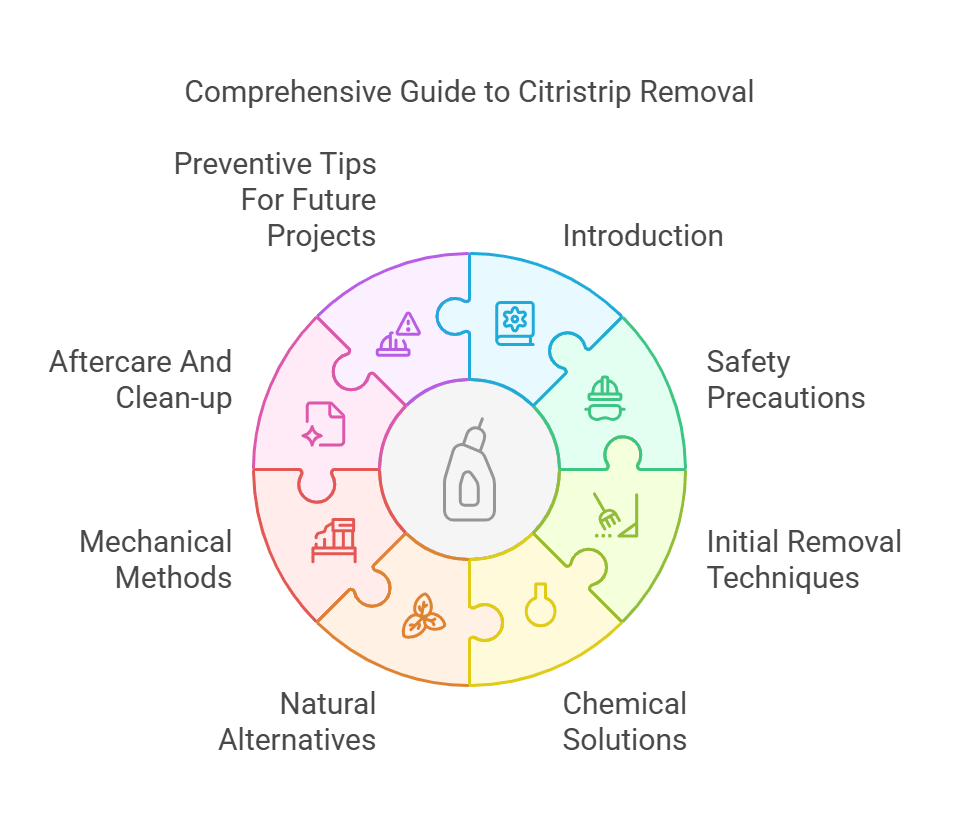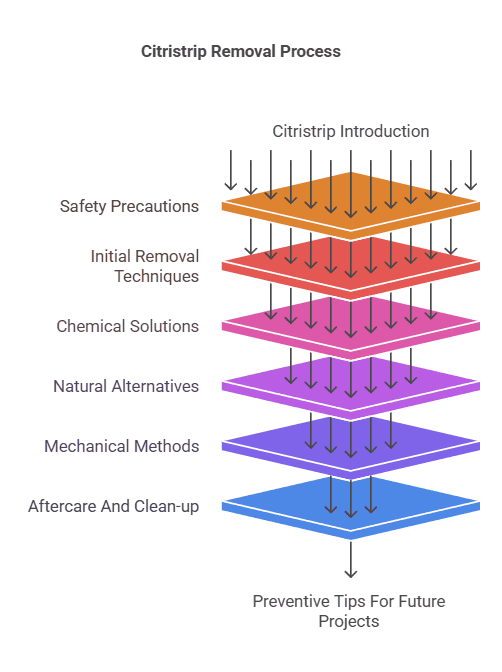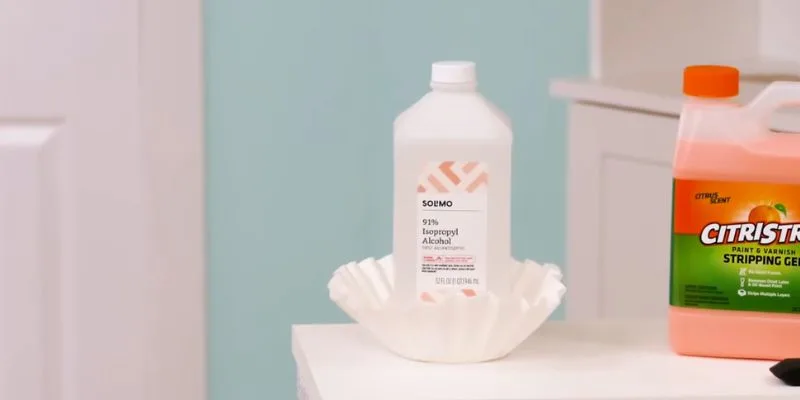To remove Citristrip, use a plastic scraper to gently lift the residue. Follow up with mineral spirits or denatured alcohol to clean the surface thoroughly.
Citristrip is a popular paint and varnish remover known for its effectiveness and citrus scent. Many DIY enthusiasts appreciate its ability to strip finishes without harsh chemicals. However, removing Citristrip residue can be tricky if not done correctly. Proper technique ensures a clean surface for your next project.
Understanding how to effectively clean up this product saves time and effort. This guide will walk you through simple steps to remove Citristrip safely and efficiently, ensuring your workspace remains tidy and ready for your next creative endeavor. Let’s dive into the best methods to achieve a residue-free finish.
Introduction To Citristrip
Citristrip is a popular paint stripper known for its effectiveness. Many people use it for removing old paint. Its pleasant citrus scent makes it more appealing than other products.
Despite its popularity, removal challenges often arise. The gel can stick to surfaces, making it hard to wipe away. Some users notice residue left behind after scrubbing.
Using the right tools helps make the process easier. A plastic scraper can remove stubborn bits without damaging surfaces. Clean with warm, soapy water to eliminate any remaining traces.
Safety Precautions
Using protective gear is very important. Always wear gloves to protect your hands. Safety goggles will shield your eyes from splashes. A mask helps avoid breathing in harmful fumes.
Set up your workspace in a well-ventilated area. Open windows and use fans to keep air flowing. This reduces the chances of inhaling strong odors. Keep the area clean and free of clutter. Use a drop cloth to catch any spills.

Initial Removal Techniques
Use gentle scraping tools to remove Citristrip effectively. Plastic scrapers work well without damaging surfaces. Avoid metal tools as they can scratch. Always test a small area first to check for any damage.
Warm water helps loosen the residue. Mix warm water with a mild soap. Dampen a cloth with the soapy water and wipe the area. This method softens the Citristrip for easier removal.
After scraping, rinse the area with clean water. This step ensures all residue is gone. Dry the surface thoroughly to prevent moisture damage.
Chemical Solutions
Choosing the right solvent is crucial for effective Citristrip removal. Mineral spirits and acetone are popular options. They can help dissolve the residue quickly.
Application is key to successful results. Use a clean cloth or brush to apply the solvent. Make sure to cover all areas well.
Dwell time is important too. Allow the solvent to sit for 10 to 30 minutes. This gives it time to work on the Citristrip.
Always test a small area first. This ensures the surface won’t be damaged. Follow these tips for the best results!
Natural Alternatives
Natural alternatives can help remove Citristrip effectively. Vinegar is a strong cleaner that breaks down residues. Mix equal parts of vinegar and water in a spray bottle. Spray the mixture on the surface and let it sit for a few minutes. Wipe it away with a cloth.
Baking soda is another great option. Make a paste by mixing baking soda with water. Apply the paste to the affected area and let it sit. Scrub gently with a sponge until the Citristrip comes off.
Citrus-based removers also work well. These products use natural citrus oils to break down paint. They are less harsh than chemical strippers. Apply according to the product instructions for the best results.
Mechanical Methods
Abrasive scrubbing is an effective way to remove Citristrip. Use a scrub brush or a coarse sponge. Apply firm pressure to lift the residue. Always scrub in a circular motion. Rinse the area with water after scrubbing.
Power washing can also help. It blasts away stubborn Citristrip effectively. Use a power washer with a suitable nozzle. Keep the nozzle at least 12 inches away from the surface. Move the spray in even, sweeping motions for best results.
Aftercare And Clean-up
After using Citristrip, it’s important to neutralize the surface. Use a mixture of water and baking soda. This helps to stop any remaining chemicals from working. Apply the mixture using a clean cloth or sponge. Rinse thoroughly with clean water to remove all residues.
Disposing of residues is crucial for safety. Place used materials in a sealed container. Check local rules for hazardous waste disposal. Never throw residues in regular trash. Follow the guidelines to ensure safe disposal.
| Item | Disposal Method |
|---|---|
| Used rags | Seal in a container |
| Citristrip residue | Follow local hazardous waste rules |

Preventive Tips For Future Projects
Using proper application techniques is key to avoiding messes. Always apply Citristrip in thin, even layers. This helps it work better and makes removal easier.
Before using, test it on a small area. This shows how the surface reacts. Protect surrounding areas with tape or plastic sheeting. This prevents unwanted spills and stains.
After treating surfaces, keep them clean. Use a gentle cleaner to maintain the finish. Avoid harsh chemicals that can damage the surface.
| Tip | Details |
|---|---|
| Application | Thin, even layers work best. |
| Testing | Always test on a small area first. |
| Protection | Use tape or plastic sheeting. |
| Maintenance | Use gentle cleaners for treated surfaces. |
Troubleshooting Common Issues
Removing Citristrip can leave residue stains on surfaces. Use a soft cloth dampened with water. Gently wipe the area until the stains disappear. If needed, apply a little dish soap for extra cleaning power.
Some surfaces may suffer from damage after using Citristrip. Check for signs like scratches or discoloration. If you notice any damage, stop using abrasive tools. Use a gentle cleaner instead to protect your surfaces.
Always test any product on a small, hidden area first. This helps avoid further damage and ensures the surface remains intact.

Frequently Asked Questions
How Do I Remove Citristrip From Surfaces?
To remove Citristrip, use a plastic scraper to gently lift the residue. Follow this by applying a solvent like mineral spirits to dissolve any remaining product. Finally, clean the surface with warm, soapy water to ensure all traces are gone.
Always wear protective gloves during the process.
What Is The Best Way To Clean Citristrip?
The best way to clean Citristrip is by using a combination of scraping and solvent application. Start by scraping off excess product. Then, use mineral spirits or denatured alcohol for thorough cleaning. Rinse the area with soap and water afterward to eliminate any lingering residue.
Can Citristrip Damage Wood Surfaces?
Yes, Citristrip can damage wood surfaces if left too long. Its active ingredients can strip away wood’s natural finish and color. Always monitor the application closely and avoid prolonged exposure. Test on a small, inconspicuous area first to gauge its effects on your specific wood type.
Is Citristrip Safe For Indoor Use?
Citristrip can be used indoors, but caution is essential. Ensure proper ventilation to avoid inhaling fumes. Use protective gear like gloves and masks. It’s advisable to work in well-ventilated spaces to minimize exposure to harmful chemicals. Always follow the manufacturer’s safety guidelines.
Conclusion
Removing Citristrip can be straightforward with the right techniques. Always wear protective gear and work in a well-ventilated area. Using the appropriate solvents and tools will make the process easier. With patience and care, your surfaces will be clean and ready for the next step.
Enjoy your refinishing project!

